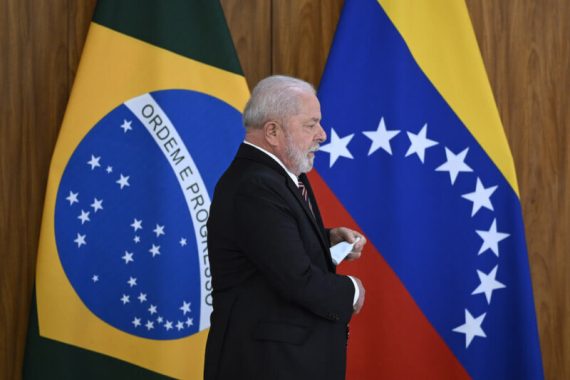B
razil has been at the center of speculations between Western expectations towards a renewed regional leadership and the increasing ties with BRICS. In April 2023, Lula da Silva, or simply Lula, Brazil’s president, visited China, welcomed Sergei Lavrov, Russia’s minister of foreign affairs, in Brasilia, and sent Celso Amorim, his closest foreign policy advisor, to meet Volodímir Zelenski. While Lula is showing democratic credentials and holds hard feelings towards Washington, Brazil’s new international strategy looks to take advantage of the great power competition with an active nonaligned perspective. Latin America seems to be going in the same direction but not necessarily due of Brazil’s new active diplomacy.
Brazil is back
After overcoming a judicial process that included serving a period in prison and returning to the political arena, Lula’s 2023 electoral victory allowed him to resume an active foreign policy with an autonomist orientation that seeks a balance between developed Western powers and revisionist visions of the global order. As Ryan Berg, director of the Americas Program at the at the Center for Strategic and International Studies (CSIS), argues, Brazil is hedging among great powers and pursuing an agenda of nonalignment, as exemplified in Lula’s visit to Beijing.
Lula has made clear that his priority is to focus on Brazil’s international reinsertion, strongly criticizing the Bolsonaro era both for its authoritarian attitudes domestically and for its erratic foreign policy. Among the main priorities of his new international agenda are the search for peace in the Ukrainian conflict, the establishment of a new regional leadership, and an active and determined projection in the Global South. Special attention has been given to regions where Brazil had regressed in the Bolsonaro era, such as the Middle East and Africa.
However, the new administration faces significant challenges due to the current international landscape, which differs considerably from when it left power. Back then, Brazil was considered a rising star and major powers had a generally positive perception of its role in the global governance agenda—at least until the signing of the tripartite agreement with Iran and Turkey. Today, however, strategic competition among major powers imposes constraints on pursuing a more autonomous foreign policy, especially vis-à-vis traditional partners such as Washington or new strategic partners such as Moscow.
Autonomous decisions have a higher cost. Moreover, the regional context has changed. During the Bolsonaro era, Brazil became a major non-NATO ally (MNNA), which increased its degree of strategic interdependence with the U.S., while the growing presence of China forces Brazil to have a more balanced position given the existing tensions between China and the U.S.
Finally, Lula intends to rebuild the Union of South American Nations (USAN, or UNASUR in Spanish), but South America is less ideologically and politically homogenous than it used to be, which in some ways hinders plans to relaunch this regional body that was deactivated during the previous administration.
Latin America and the Russo-Ukrainian War
The Russian presence has not gone unnoticed in discussions in Latin America. The war in Ukraine is the focus of foreign policy debate in most of Latin America; the discussions are framed in a context of how the region should navigate the rise of China and the emergence of new global actors such as Russia. Among academics, experts, and decision-makers, there are broadly two perspectives on Latin America’s place in an increasingly multipolar world: on the one side, to side with the U.S., or China and/or Russia in the new great power competition, or, on the other, to remain outside of the competition.
The alignment calls for a choice between the United States and China. This option is generally marginal in Latin American foreign policy discussions, and often has a strong liberal ideological component. The strong pro-democratic and liberal affinities generally favor a special closeness with the United States and the Western world, but there are also growing pro-China sympathies, for example, in Venezuela and among some of Latin America’s left-wing movements.
Across the region there is a near consensus not to engage in the new great power competition, while seeking opportunities for economic development and strategic alliances with other countries. The second option has different expressions but can be summarized as a form of nonalignment. The recent book “Latin American Foreign Policies in the New World Order: The Active Non-Alignment Option” edited by Fortin, Heine and Ominami reunites different voices which call for an equidistant position between the White House and Beijing while seeking to deepen regional integration and more active diplomacy both with rising players and in the Global South.
Recommended
For example, facing the Russo-Ukrainian War, the major Latin American regional players—Brazil, Argentina, and Mexico—have shown a more pragmatic and less forceful stance with respect to condemnation, with a mixture of balanced positions and a search for compensation. Thus, no country in Latin America adopted sanctions against Russia. The case of Brazil is particularly interesting since it shows an important degree of continuity between Bolsonaro and Lula except for the new “peace coalition” project which has been at the core of the current presidential diplomatic maneuvers. Although Bolsonaro’s and Lula’s diplomatic responses offered different nuances within and across different regional players, they signaled an autonomous perspective facing global pressures.
What does active nonalignment mean for Latin America?
Are Brazil and Latin America nonaligned? The answer is yes. Neutrality and nonalignment have been at the center of Latin America’s external choices both in relation to the Russo-Ukrainian War and the U.S.-China strategic competition. However, only to stand aside in a changing global environment is not enough to strengthen agency in world politics. Latin America suffers from a structural relevance deficit in the global scenario, so a more active and prompt approach towards global affairs is needed. Diversification, open regionalism, multilateralism, and soft power are optimal routes to increase regional presence and relative weight in international affairs.
While nonalignment is a fact in current times, the active side of the equation seems to be far behind regional needs. Regional fragmentation and stagnation have been increasing in recent years and the multilateral position does not mean that the regional players coordinate their policies—even those related to the Russo-Ukrainian War— while diversification and soft power policies fluctuate in relation to the importance that governments give to international issues. The relations between Turkey and Latin America are a vivid example of the lack of continuity, with the initiative usually coming from Ankara. In the end, Lula’s new Brazil offers an opportunity to put the region back on the international stage, although it will most likely be following Brasilia’s and not a collective agenda.





